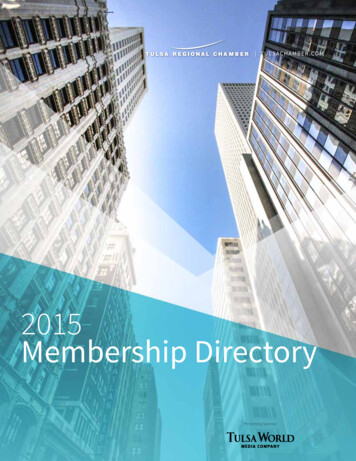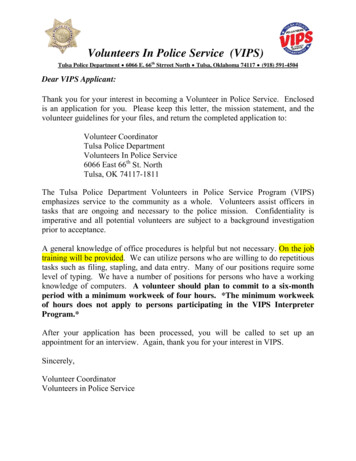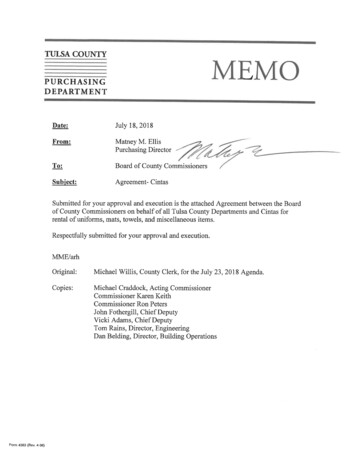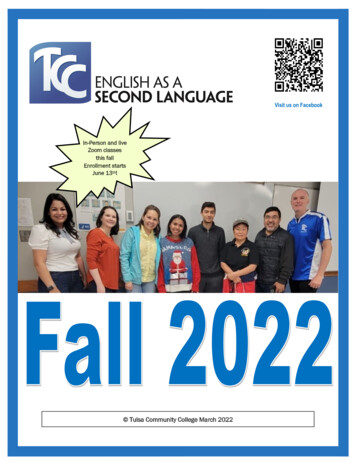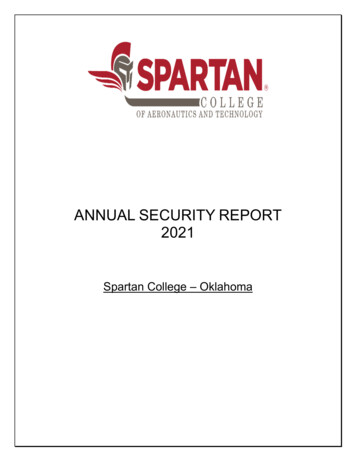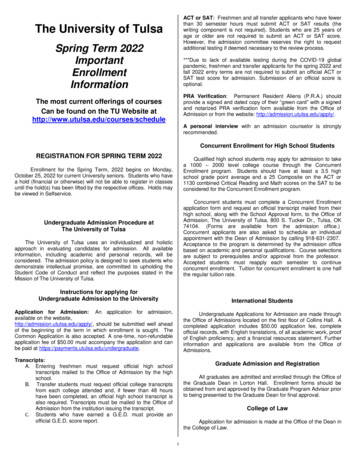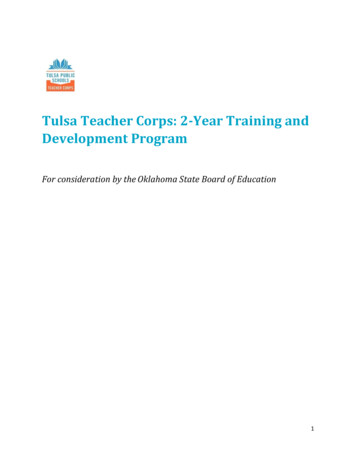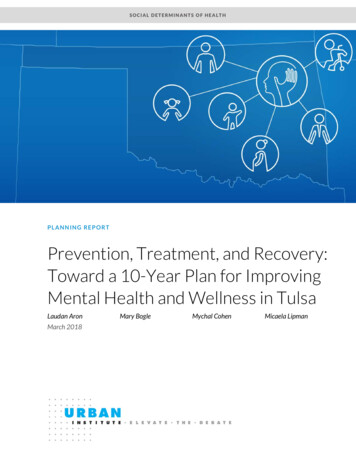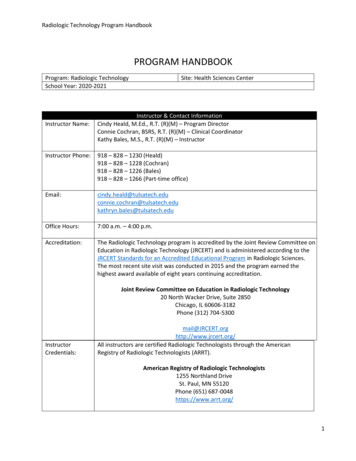
Transcription
Radiologic Technology Program HandbookPROGRAM HANDBOOKProgram: Radiologic TechnologySchool Year: 2020-2021Instructor Name:Site: Health Sciences CenterInstructor & Contact InformationCindy Heald, M.Ed., R.T. (R)(M) – Program DirectorConnie Cochran, BSRS, R.T. (R)(M) – Clinical CoordinatorKathy Bales, M.S., R.T. (R)(M) – InstructorInstructor Phone:918 – 828 – 1230 (Heald)918 – 828 – 1228 (Cochran)918 – 828 – 1226 (Bales)918 – 828 – 1266 (Part-time an@tulsatech.edukathryn.bales@tulsatech.eduOffice Hours:7:00 a.m. – 4:00 p.m.Accreditation:The Radiologic Technology program is accredited by the Joint Review Committee onEducation in Radiologic Technology (JRCERT) and is administered according to theJRCERT Standards for an Accredited Educational Program in Radiologic Sciences.The most recent site visit was conducted in 2015 and the program earned thehighest award available of eight years continuing accreditation.Joint Review Committee on Education in Radiologic Technology20 North Wacker Drive, Suite 2850Chicago, IL 60606-3182Phone (312) //www.jrcert.org/All instructors are certified Radiologic Technologists through the AmericanRegistry of Radiologic Technologists (ARRT).American Registry of Radiologic Technologists1255 Northland DriveSt. Paul, MN 55120Phone (651) 687-0048https://www.arrt.org/1
Radiologic Technology Program HandbookProgram History:In 1953, Dr. Dave B. Lhevine began the Hillcrest Medical Center School of RadiologicTechnology. In 1984, Tulsa Technology Center (TTC) became the program sponsor. Theprogram has undergone many changes over the years, and continues to maintain highstandards and expectations for its students.InstructionalPhilosophy:We believe that every individual is a unique creation and that it is our privilege andresponsibility to help in the realization and fulfillment of each individual’s accountabilityto self and man-kind. There are two educations, one teaching us how to earn a livingand the other teaching us how to live. We subscribe to the belief that career andtechnology education is an essential part of the two educations. There is dignity inwork, and work is one of our best means of developing intelligent use of the hands andminds. Education is a process by which belief and behavior patterns become a part ofthe student’s personality. We want the student to attain the fullest growth anddevelopment as a person, and a contributing, self-directing, responsible member ofsociety and the healthcare ption:Campus/Site InformationAmy Beck, Counselor (Radiologic Technology program)(918) 828-1233 – office 2127Carla Henson, Counselor(918) 828-1231 – office 2222Jil Gaylor, Counselor(918) 828-1232 – office 2126Debby Peaster, HSC Campus Director(918) 828-1202Dr. Russell Prentice, HSC Assistant Director(918) 828-1202Program InformationRadiologic TechnologistA Radiologic Technologist (Radiographer) uses critical thinking and independentjudgment to obtain a diagnostic imaging study while maintaining quality patient careand minimizing radiation exposure.The goal of the Radiologic Technology program faculty is to assist students inbecoming highly competent radiographers. We use the word “assist” to help studentsunderstand that they are responsible for successfully completing the program, as wellas passing the American Registry of Radiologic Technology examination.This experience will likely be very different from any you have encountered before. Assuch, we expect that you become familiar with all program and school policies. Thesepolicies encompass the professional, clinical and academic behaviors that are to beexplicitly followed. It is the student’s responsibility to become knowledgeable of thishandbook contents. Students will sign a statement verifying that they understand thecontents and that they agree to abide by the policies and procedures. The form will beretained in the student’s permanent file for the duration of their time in the program.During the student’s time in the program, the faculty will do our best to preparestudents to become a professional radiologic technologist who is eligible to sit for thenational certification examination. However, graduation does not guarantee passageof the exam. This program is one that takes much time and dedication on the part ofthe student, but it can lead to a successful career.2
Radiologic Technology Program HandbookCourses & Hours:The program follows the two year ASRT Radiography Curriculum, most recentlyrevised in 2017. Both the academic and clinical portions of the program arecompetency based with clearly written objectives for the students to follow.A syllabus for each course will be posted on Blackboard. It is the responsibility of eachstudent to be fully aware of the contents of the syllabus and the consequences whichexist if the student deviates from any policy regarding classroom conduct.Students are responsible for the timely completion of all assignments, keeping currentwith reading from texts, preparing for classes and completing online assignments bytheir due date. Students are encouraged to form study groups and make use of allclassroom and school references. Instructors have an open door policy for individualquestions and are accessible to students before and after class, as well as during officehours. Students may also email faculty with questions. It is the student’sresponsibility to seek timely assistance in content areas that are challenging them.The program’s philosophy recognizes the importance of grading as a method ofassessing content knowledge. However, understanding corrections from assessmentmethods is much more significant. The program does not promote memorization as amethod of understanding, but challenges students to use higher level learning skillssuch as analysis, contrast and comparison, and critical thinking. The student’s abilityto attain a higher level of understanding and use critical thinking skills will have adramatic impact on their ability to pass the ARRT certification exam.Course DescriptionsFirst Year Courses:HLTH – 0024Patient Care in the Radiologic Sciences63 hoursHLTH – 0028Ethics and Law in the Radiologic Sciences33 hoursHLTH – 0025Intro to Radiologic Science & Healthcare48 hoursHLTH– 0026Radiographic Procedures IContent provides the concepts of optimal patient care, including consideration for thephysical and psychological needs of the patient and family. Routine and emergencypatient care procedures are described, as well as infection control procedures usingstandard precautions. The role of the radiographer in patient education is identified.This content provides a foundation in ethics and law related to the practice of medicalimaging. An introduction to terminology, concepts and principles will be presented.Students will examine a variety of ethical and legal issues found in clinical practice.The content provides an overview of the foundations of radiography and thepractitioner’s role in healthcare delivery. Principles, practices and policies of thehealthcare organizations are examined and discussed in addition to the professionalresponsibilities of the radiographer.150 hoursContent is designed to provide the knowledge base necessary to perform standardradiographic procedures. Consideration is given to the evaluation of optimal diagnosticimages. Laboratory experience complements the didactic portion. This course providesthe student with theoretic concepts, terminology and clinical application for routinepositioning procedures. Students will be given an opportunity to demonstrate theirknowledge and skill in performing the simulated exams, which will later become a3
Radiologic Technology Program Handbookbasis for competency in the clinical practicum. Knowledge of anatomic structures andradiographic quality will be evaluated in classroom activities.HLTH – 0027Image Analysis I48 hoursHLTH – 0080A&P for Radiography IHLTH – 0081Clinical Practice IContent is designed to provide a basis for analyzing radiographic images. Included arethe importance of minimum imaging standards, discussion of a problem-solvingtechnique for image evaluation, and the factors that can affect image quality.78 hoursContent establishes a knowledge base in anatomy and physiology. Components of thecells, tissues, organs and body systems are described and discussed. The fundamentalsof sectional anatomy relative to routine radiography are addressed.247 hoursContent and clinical practice experience is designed to sequentially develop, apply,critically analyze, integrate, synthesize and evaluate concepts and theories in theperformance of radiologic procedures. Through structured, sequential, competencybased clinical assignments, concepts of team practice, patient-centered clinicalpractice and professional development are discussed, examined and evaluated.Clinical practice experiences are designed to provide patient care and assessment,competent performance of radiologic imaging and total quality management. Levelsof competency and outcomes measurement ensure the well-being of the patient priorto, during and following the radiologic procedure.HLTH – 0003 Core Medical Terminology45 hoursMedical Terminology is designed to develop in the students a working knowledge ofthe language of medicine. Students acquire word building skills by learning prefixes,suffixes, roots and abbreviations. By relating terms to body systems, students identifyproper uses of words in a medical environment. Knowledge of medical terminologyenhances students’ ability to successfully secure employment or pursue advancededucation in healthcare.HLTH – 0033Radiation Pathology33 hoursHLTH – 0082Radiographic Procedures IBHLTH – 0083Image Analysis IBContent introduces concepts related to disease and etiological considerations withemphasis on radiographic appearance of disease and impact on exposure factorselection.132 hoursContent is designed to provide the knowledge base necessary to perform standardradiographic procedures. Consideration is given to the evaluation of optimal diagnosticimages. Laboratory experience complements the didactic portion. This course providesthe student with theoretic concepts, terminology and clinical application for routinepositioning procedures. Students will be given an opportunity to demonstrate theirknowledge and skill in performing the simulated exams, which will later become abasis for competency in the clinical practicum. Knowledge of anatomic structures andradiographic quality will be evaluated in classroom activities.33 hoursContent is designed to provide a basis for analyzing radiographic images. Included arethe importance of minimum imaging standards, discussion of a problem-solvingtechnique for image evaluation, and the factors that can affect image quality.4
Radiologic Technology Program HandbookHLTH – 0084A&P for Radiography IIHLTH – 0038Clinical Practice IB63 hoursContent establishes a knowledge base in anatomy and physiology. Components of thecells, tissues, organs and body systems are described and discussed. The fundamentalsof sectional anatomy relative to routine radiography are addressed.276 hoursContent and clinical practice experience is designed to sequentially develop, apply,critically analyze, integrate, synthesize and evaluate concepts and theories in theperformance of radiologic procedures. Through structured, sequential, competencybased clinical assignments, concepts of team practice, patient-centered clinicalpractice and professional development are discussed, examined and evaluated.Clinical practice experiences are designed to provide patient care and assessment,competent performance of radiologic imaging and total quality management. Levelsof competency and outcomes measurement ensure the well-being of the patient priorto, during and following the radiologic procedure.Second Year Courses:HLTH– 0089Clinical Practice II282 hoursHLTH – 0085Radiographic EquipmentHLTH – 0087Pharmacology for RadiographyHLTH – 0042Radiation BiologyHLTH – 0090Radiation ProductionContent and clinical practice experience is designed to sequentially develop, apply,critically analyze, integrate, synthesize and evaluate concepts and theories in theperformance of radiologic procedures. Through structured, sequential, competencybased clinical assignments, concepts of team practice, patient-centered clinicalpractice and professional development are discussed, examined and evaluated.Clinical practice experiences are designed to provide patient care and assessment,competent performance of radiologic imaging and total quality management. Levelsof competency and outcomes measurement ensure the well-being of the patient priorto, during and following the radiologic procedure.78 hoursContent establishes a knowledge base in radiographic, fluoroscopic and mobileequipment requirements and design. The content also provides a basic knowledge ofquality control.21 hoursContent provides basic concepts of pharmacology, venipuncture and administration ofdiagnostic contrast agents and intravenous medications. The appropriate delivery ofpatient care during these procedures is emphasized.48 hoursContent provides an overview of the principles of the interaction of radiation withliving systems. Radiation effects on molecules, cells, tissues and the body as a wholeare presented. Factors affecting biological response are presented, including acuteand chronic effects of radiation.24 hoursContent establishes a basic knowledge of atomic structure and terminology. Alsopresented are the nature and characteristics of radiation, x-ray production and thefundamentals of photon interactions with matter.5
Radiologic Technology Program HandbookHLTH– 0045Career Preparation for Radiography18 hoursHLTH – 0049Principles of Exposure and Image ProductionHLTH– 0091Clinical Practice II CapstoneHLTH – 0043Radiation ProtectionHLTH – 0051Digital Imaging Acquisition and DisplayHLTH – 0092Comprehensive Radiography ReviewThis course emphasizes communication skills and specific career knowledge for thehealth care professional. To support an occupational job search, a functional resumewill be produced that summarizes the student’s education, personal and professionalachievements and work experience. To enhance their professional images, eachstudent will construct cover letters and thank you notes that may be updated orchanged as needed. Advanced career modality requirements and preparation will beinvestigated, as well as the requirements for professional continuing education andopportunities for life-long learning.48 hoursContent establishes a knowledge base in technical factors that govern the imageproduction process.254 hoursContent and clinical practice experience is designed to sequentially develop, apply,critically analyze, integrate, synthesize and evaluate concepts and theories in theperformance of radiologic procedures. Through structured, sequential, competencybased clinical assignments, concepts of team practice, patient-centered clinicalpractice and professional development are discussed, examined and evaluated.Clinical practice experiences are designed to provide patient care and assessment,competent performance of radiologic imaging and total quality management. Levelsof competency and outcomes measurement ensure the well-being of the patient priorto, during and following the radiologic procedure.30 hoursContent presents an overview of the principles of radiation protection, including theresponsibilities of the radiographer for patients, personnel and the public. Radiationhealth and safety requirements of federal and state regulatory agencies, accreditationagencies and health care organizations are incorporated.48 hoursContent imparts an understanding of the components, principles and operation ofdigital imaging systems found in diagnostic radiology. Factors that impact imageacquisition, display, archiving and retrieval are discussed. Principles of digital systemquality assurance and maintenance are presented.72 hoursThis course provides a comprehensive review of the radiography curriculum inpreparation for taking the certification exam given by The American Registry ofRadiologic Technologists (ARRT). Identified areas of weakness will help the studentfocus on the curriculum items that need concentrated study. The computerized testingformat of the ARRT exam will be emphasized.6
Radiologic Technology Program HandbookGoals/OutcomesProgram Mission:To prepare people for success in the healthcare field as competent entry levelradiographers.Program Goals:Students will be clinically competent.Student Learning Outcomes: Students will accurately position patients for radiographic exams. Students will simulate exams for evaluation of continued skill and retention. Students will use proper radiation protection during radiographic procedures.Students will demonstrate effective communication skills.Student Learning Outcomes: Students will effectively communicate with patients. Students will construct a functional resume and cover letter. Students will communicate effectively using written communication. Students will effectively communicate with healthcare professionals.Students will demonstrate critical thinking and problem solving skills.Student Learning Outcomes: Students will critique radiographic images and determine corrective actionwhen needed. Students will critically assess the effect of various factors on the fourradiographic qualities.Students will demonstrate professional and ethical behavior.Student Learning Outcomes: Students will demonstrate professional behavior. Student will discuss and model ethical behavior. Students will demonstrate willingness to improve by receptivity to correction.The program will monitor its ongoing effectiveness through graduate and employersatisfaction.Student Learning Outcomes: Students will complete the radiologic technology program. Graduates will evaluate the program positively. Employers will rate their satisfaction with graduates’ skills. Graduates will pass the ARRT credentialing exam. Graduates will be placed in radiography jobs.Program Effectiveness:The program’s benchmarks are: Students (75%) will complete the program. Graduates (80%) will evaluate the program positively. Employers (80%) will rate their satisfaction with graduate’s skills as eithergood or excellent. Graduates (80%) will pass the ARRT credentialing exam on the first attempt. Graduates (80%) will be placed in related jobs within 12 months of programcompletion.7
Radiologic Technology Program HandbookIn accordance with JRCERT requirements (Standard 5.2), program effectiveness data isaveraged over a five year period. Data analysis for graduates from 2015-2019 shows: 78% of students completed the program. 97% of graduates evaluated the program positively. 94% of employers rated their satisfaction with graduate’s skills at either goodor excellent. 81% of graduates passed the ARRT credentialing exam on the first attempt. 96% of graduates were placed in related jobs within 12 months of programcompletion.Certifications:Students who successfully complete the Radiologic Technology program are eligible totake the national certification exam offered by the American Registry of RadiologicTechnologists (ARRT).Candidates for certification must answer three ethics-related questions on theirapplication form: Have you ever been convicted in court of a misdemeanor, felony or a similaroffense in a military court martial? Have you had any professional license, permit, registration or certificationdenied, revoked, suspended, placed on probation, under consent agreementor consent order, voluntarily surrendered or subjected to any conditions ordisciplinary actions by a regulatory authority or certification board (other thanARRT)? Have you ever been suspended, dismissed or expelled from an educationalprogram that you attended in order to meet ARRT certification requirements?These questions can be found on the ARRT web site at: ents/ethics-requirements/ethics-questions. The ARRTinvestigates all potential violations in order to determine eligibility, and will evaluateeach candidate on an individual basis. Call the ARRT with any questions abouteligibility. Phone (651) 687-0048.The program faculty distributes the application for the ARRT examination. The fee forthe ARRT examination is currently 200.00, but is subject to change.The ARRT examination is given at area testing centers. Students will receiveinformation regarding scheduling procedures from the ARRT after their application hasbeen processed.CareerOpportunity:The program is designed to prepare post-secondary adult students for entry levelemployment as Radiologic Technologists. Radiologic Technologists work under thesupervision of Radiologists. Radiologic Technologists work in many areas of diagnosticimaging, including but not limited to: general radiography, computed tomography,magnetic resonance imaging, ultrasound, mammography, fluoroscopy, vascular imaging,mobile radiography, or trauma & surgical imaging.8
Radiologic Technology Program HandbookEstimated Tuition, Fees and BooksCost:Estimated Tuition Fees: 8,700.00Additional Required Costs: 2,100.00****There may be additional required cost as defined in the program handbook. Tuition,fees, career majors, course and hours are subject to change without notice.Student Activity FeeA 20 student activity fee is due at the beginning of each school year. The funds areused for National Radiologic Technologist Week (NRTW) and graduation expenses.Payment can be cash or check (made to Tulsa Tech) and can be given to a Rad Techinstructor. Each student is encouraged to keep their receipt for payment verification.Financial AidFinancial aid (FA) counselors are available to assist students with their financial needs.The Financial Aid office is located in the Career Services Center building on the LemleyCampus, 3420 S. Memorial Drive. An appointment with the Financial Aid office may bemade by calling (918) 828-4215.When a student receives confirmation from the Department of Education about a PELLgrant, or receives any other type of scholarship, they should contact the FA office andprovide a copy of the award letter as soon as possible.A Payment Authorization form will be given to each student at the beginning of eachschool year. Tuition/fee payments can be made to Sarah Long (918-828-1041) in theBursar Office, in the Career Services Center on the Lemley Campus.Eligibility for AdmissionsEntrance Requirements Adult students only (age 18 or older) High school diploma or G.E.D. Basic computer literacyCertification in Radiologic Technology requires a college degree. This specification was put into place by theARRT in 2015. Students who want to apply for and take the Radiography program at Tulsa Tech should:Hold an associate degree or higher from an institution recognized by ARRT, orBe close to earning a degree from an institution recognized by ARRT (degree audit required prior to admission).District ies/9
Radiologic Technology Program HandbookClass Times:Class HoursScheduleClass hours are 7:45 am – 2:30 pm. Lunch break is 10:45 a.m. – 11:30 a.m., and thereare two breaks per day.Books, notebooks, and writing implements must be brought to the classroom. All classinformation will be posted on Blackboard for student access. It is the student’sresponsibility to obtain or make up class material missed due to absence.Clinical HoursMost clinical practice hours between 7:00 a.m. – 2:30 p.m. Students are allowed 30minutes for lunch break when at clinical. Lunch time will be determined by thesupervising technologist and/or work flow. Working through lunch/dinner break doesnot give a student permission to leave early.Each student is allowed two (2) 10-minute breaks per day. During clinical hours, astudent must consult with the area supervisor before leaving the radiologydepartment or scheduled area for a break or for lunch.Grading Scales:Classroom Procedure & ExpectationsThe following criteria will be used for the assignment of letter grades, gradingscales and percentage grades for students:ABCDFTulsa Tech’s Grading PolicyGradingMethodology:100 – 90%89 – 80%79 – 70%69 – 60%59 – 0 %Radiography is a profession in which less than adequate performance may cause patientsto suffer harm; therefore, high program standards must be maintained to insure theeffectiveness and competency of graduates and their successful completion of thenational certification exam.Academic Courses – Students are required to maintain an 80% average in each academiccourse. Students can access their course grades at any time through Blackboard.Students are expected to monitor their academic progress on a regular basis.Participation is a major component of the learning process. Students are expected toparticipate in class discussions, demonstrations, lab activities and clinical assignments.Exams are given regularly. If at any time during a course the student’s grade averagefalls to near 80%, or if the student demonstrates a lack of satisfactory academic progress,he/she will be counseled by the instructor and/or the Program Director. If the student’soverall grade continues to fall or if the student fails to make acceptable academicprogress, he/she will be placed on Academic Probation. If a student does notsatisfactorily meet the course objectives and pass the course, he/she will be unable to10
Radiologic Technology Program Handbookprogress in the curriculum. Failure to meet probationary requirements or to pass anycourse in the program can result in removal from the program.Clinical Practice – Students are required to maintain an 80% average in the Clinical Practicecourses. The clinical grade is based on Professionalism, Patient Exam Competencies,Clinical Area Competencies, and Clinical Tests that are given by a clinical Instructor. A fullexplanation of these requirements is given at the beginning of the program. Failure tomaintain an 80% average in the Clinical Practice courses will result in being placed onClinical Probation. A Clinical Test will be given each semester. The overall score for aClinical Test must be 90% or above. Failure to maintain an 80% clinical grade, or meetclinical competency requirements after remediation at any level, may result in removalfrom the program.Testing ProceduresStudent’s knowledge and skills are assessed frequently in order to provide feedbackregarding progress in the program. Exams are pre-announced by the instructor, andinclude the information related to the learning objectives of the topic. An exam may bea skills or competency demonstration, computer generated questions, writtenpaper/pencil format or an oral report. Consult the course syllabi for additionalinformation regarding testing protocol.Absence on Examination DayStudents must complete a missed examination on the day they return to class. Delayedexamination dates provide an unfair advantage and are disrespectful to those studentswho prepare for their examinations on schedule.Extra Credit:Refer to individual course syllabusMakeup Work:Refer to individual course syllabusTeachingMethods:Professionalism:Refer to individual course syllabusThe American Society of Radiologic Technology (ASRT) Code of Ethics should influenceall actions. Students are expected to conduct themselves as professionals at all times.All regulations concerning safety, behavior, language, appearance, discipline andattendance must be observed. Unacceptable conduct will first be handled by theinstructor, then follow the chain of authority. Such conduct may result in suspensionand/or dismissal from the program and Tulsa Tech.Unprofessional conduct as outlined in the Tulsa Tech policies, the RadiologicTechnology Program Handbook, the Radiologic Technology Clinical LAP, ARRTProfessional Ethics, or the clinical affiliate policies will not be tolerated.Student Use of Mobile/Electronic DevicesDuring class, all cell phones must be on turned off/silent and placed in the designatedarea. Students may use cell phones outside of the classroom while on scheduledbreaks. Taking unauthorized pictures or videos of exams, quizzes, students, faculty orother classroom related information is not permitted. Sharing information related toassignment or test answers is considered cheating and is not permitted.11
Radiologic Technology Program HandbookApple watches or other such devices must be put away in the student’s bag or lockerduring any type of testing.Student cell phones are not permitted in the x-ray lab.Due to a mandate by the local clinical practice sites, no student may carry a cell phoneon their person during clinical practice. Situations have been documented thatindicate HIPAA violations. All cell phones must be kept in a locker or in the student’sautomobile. Any student caught carrying a cell phone during clinical practice may beremoved from the clinical site and the program.In case of family emergency situations, a student may be contacted via the hospitalphone system. All clinical site phone numbers are listed on pages 24-26 of thishandbook.In the unusual situation where a temporary condition exists and a student must beimmediately accessible, a release form must be filled out and the information must beverified. The clinical site will determine if the student is allowed to carry a cell phonefor a limited period of time.Each student is expected to adhere to the following professionalism objectives for clinicalpractice: Attend clinical practice each scheduled day. Arrive to the clinical site on time and stay for the entire shift. Maintain proper documentation required by the accrediting body and by TulsaTech policy. Uphold professional appearance according to industry standards and programpolicy. Prese
Radiologic Technology Program Handbook . 1 . PROGRAM HANDBOOK . Program: Radiologic Technology Site: Health Sciences Center School Year: 2020-2021 . 1230 (Heald) 918 - 828 - 1228 (Cochran) 918 - 828 - 1226 (Bales) 918 - 828 - 1266 (Part-time office) Email: cindy.heald@tulsatech.edu connie.cochran@tulsatech.edu: kathryn.bales .
